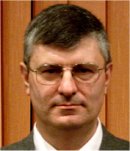|
Plenary
Lecture
Machining Process & System Dynamics Identification by
Using Chaotic Models

Professor Gabriel Frumusanu
Manufacturing Science and Engineering Department
"Dunarea de Jos" University of Galati, ROMANIA
E-mail:
gabriel.frumusanu@ugal.ro
Abstract: To reach the best momentary values of
the machining process performances (concerning
productivity, precision, surface quality etc.) it is
necessary to continuously monitor the deviations from
the programmed values of the cutting process parameters
(caused especially by instability) and to counteract
them. This is possible only if we have a technological
system’s dynamics model to express the relation between
the machining process input parameters and their
consequences regarding the stability. Such a model may
be developed by starting from the equations
characterizing the physical process or by
identification. During the last decades, several models
were suggested and, more or less, validated in practice.
They all have two major inconvenient: i) the machining
process and the machining system are treated separately
and ii) they cannot give information about the position
of the system’s current functioning point relative to
its stability limit. By assuming the potential chaotic
character of the cutting process dynamics, we made
investigations concerning the possibility of identifying
the dynamics of both machining process & system,
considered together as a unique entity. There are more,
well known, chaotic classic models: logistic, Henon,
Lorenz etc. After thoroughly analyzing them, we chose
the logistic (one-dimensional) model as the most
appropriate to be used for characterizing the cutting
force (or the acceleration) variation during a cutting
process and thus, to identify the machining process &
system dynamics. By online monitoring the momentary
value of the logistic model control parameter and by
comparing it to a critical value, the position of the
system’s current functioning point relative to its
stability limit may be known.
Brief Biography of the Speaker:
Gabriel Frumusanu graduated a 5 years Mechanical
Engineering degree program at "Dunarea de Jos"
University of Galati (1987); PhD in Industrial
Engineering - at "Dunarea de Jos" University of Galati
(1999); Training stages at: "Ecole des Mines de Paris",
CEMEF, Sophia-Antipolis – France (1992); "Universita
degli Studi di Padova", Padua – Italy (1997); "Ecole
Nationale Superieure des Artes et Metiers", Angers –
France (2002). Research fields: numerical modeling of
manufacturing processes and surfaces generation; cutting
processes dynamics; metals cold forming (deep drawing,
extrusion, orbital volumetric cold forming).
Professional experience: 1988 – 1990 – Engineer
responsible of equipments maintenance at Cold Rolling
Mill from Galati Iron and Steel Company; 1990 – 2000 –
Assistant-professor at "Dunarea de Jos" University of
Galati, Manufacturing Science and Engineering
Department; 2000 – 2004 – Associate-professor, in the
same department; 2004 up to present – Professor, in the
same department.
Prof. Frumusanu participated in over 20 research
projects supported by Romanian Ministry of Education and
Science; author / co-author of over 20 scientific or
didactic books; over 100 scientific papers written or
co-authored, published to International / National
Conferences proceedings (Spain, France, Hungary, Israel,
Moldavia) and Journals. Invited professor at "Universita
degli Studi di Padova", Padua – Italy (2006). Member of
professional and scientific associations: Romanian
Association for Non-Conventional Technologies - ARTN,
Romanian Association of Managers and Engineers - AMIER,
Romanian Association of Tensometry - ARTENS; Expert of
Romanian National University Research Council - CNCSIS
and of Romanian Agency for Quality Assurance in Higher
Education - ARACIS.
|
